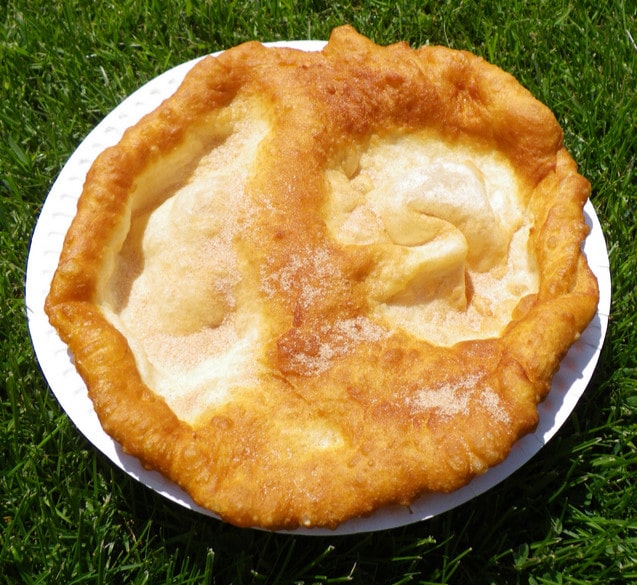
“There are three basic ingredients in the diet of Native tribes,” explains Tazbah McCullah, the marketing director of the Indian Pueblo Cultural Center. “Corn, beans and squash, which you may known as the ‘three sisters’ as they work together to help each other grow. In terms of nutrition, the corn provides the carbohydrates, the beans provide the protein and the squash provides Vitamin A.”
I’m at the Indian Pueblo Cultural Center in Albuquerque, New Mexico, standing around a table display of these Native ingredients. The Indian Pueblo Cultural Center was started in 1976 by the 19 pueblo tribes in New Mexico to provide education to the public. While their cultural exhibits, collections, pueblo recreations, photographs, dance demonstrations and events give insight into the unique facets of Native Pueblo Indian culture, so does their Pueblo Harvest Cafe, with a menu inspired by traditions and ingredients cultivated by Pueblo ancestors.
One ingredient the center has made a staple on the menu is traditional blue cornmeal mush, a recipe used by many of the older generations of Pueblo Indians. Natives use this ingredient for nutrition as it’s full of vitamins, especially zinc which is a tough mineral to get into your diet. It consists of atole — a blue corn — that is mixed with water to a consistency where it can be eaten as a porridge or mush. Some Natives will add juniper to the blue cornmeal mush to make it easier to digest.
“I think the staple of blue corn mush has meaning to Natives,” explains McCullah “It is a dish that appeals to all ages and is versatile. It can be good plain or dressed up with other flavors. It’s easy on the tummy and filling and easy to cook.”

Chackewe con Juevos
I’m visiting during breakfast, which I’m excited for as almost everything on the menu is made from scratch. The menu features everything from homemade granola with Greek yogurt and fresh fruit to blue cornmeal pancakes to breakfast frito pie. The one dish that I’m told is a must-try is the Chackewe con Huevos, a hearty meal featuring traditional cornmeal mush topped with carne adovada, two eggs, cheddar cheese and fresh diced tomatoes. Carne adovada itself is a New Mexican staple and features slow cooked red chile-braised pulled pork. Combined with the thick cornmeal mush and the buttery egg yolk, it’s a satisfying and filling dish that allows you to explore local culture through the tongue. Tip: Mix all ingredients well so all the flavors and textures meld together, then top with green chile, the iconic ingredient of New Mexican.
Another staple of the menu is the atole, a blue corn porridge they serve with golden raisins, dry prunes, cranberries and mixed nuts to make it like an oatmeal. Pubelos use atole in other ways, as well, for example, plain (the traditional way), embellished with proteins, or with milk/cream and sugar. There is even an atole beverage made by adding extra water to the atole — more than you would with the mush — which I’m told is especially delicious with chocolate.
Keep in mind, while the Pueblo Harvest Cafe serves Native Fusion you’re still getting a very authentic experience. Along with stews, breads, bean and squash-based dishes, and Indian tacos, the chef mixes different textures and combinations with what is considered traditional – for example, Carne adovada with cole slaw on a crusty roll to create a Carne Po’Boy.
“Our ‘fusion’ recipes are not necessarily modified to appeal to the “American” palate,” says McCullah. “Many visitors expect to eat the more traditional fare and seek us out for that experience. The non-traditional items are meant to appeal to all palates.”

Indian fry bread. Photo courtesy of BrandontheMandon.
No Native meal would be complete without Indian fry bread. While every culture has its own form of fry bread — beignets, donuts, zeppoles, latkes — in New Mexico you’ll find the Indian fry bread. This dish has a special meaning to the Native Pueblos, as during the early and mid-1800s when the Native Americans were displaced in overcrowded camps the government meagerly supplied these people with lard, flour, salt, sugar, baking powder/yeast, and powdered milk, meaning fry bread was one of the few meals they could make to stay alive. To make it, flour, salt, powdered milk and baking powder are mixed together with the hands — not kneaded — before it is cut into disks and fried in vegetable oil. Afterward, it is baked in a traditional horno oven. The resulting bread is lumpy, chewy and an excellent pairing with stews, meats and sauces.
Along with the above-mentioned menu items, guests of the Pueblo Harvest Cafe can enjoy traditional fare like Feast Day Stew, red chile broth with small cubes of pork; Jemez-style enchilladas made with tortillas soaked in red chile with yellow cheese and onion rolled inside and then baked; green chile stew; pinto beans cooked in their own broth; and calabacitas (squash) steamed with yellow corn mixed in, to name a few. When visiting, it can also be fun to take part in a bread- or tamale-making demonstration as well as tour the museum exhibits and artifacts for an immersive cultural experience.

Jessica Festa is the editor of the travel sites Jessie on a Journey (http://jessieonajourney.com) and Epicure & Culture (http://epicureandculture.com). Along with blogging at We Blog The World, her byline has appeared in publications like Huffington Post, Gadling, Fodor’s, Travel + Escape, Matador, Viator, The Culture-Ist and many others. After getting her BA/MA in Communication from the State University of New York at Albany, she realized she wasn’t really to stop backpacking and made travel her full time job. Some of her most memorable experiences include studying abroad in Sydney, teaching English in Thailand, doing orphanage work in Ghana, hiking her way through South America and traveling solo through Europe. She has a passion for backpacking, adventure, hiking, wine and getting off the beaten path.








